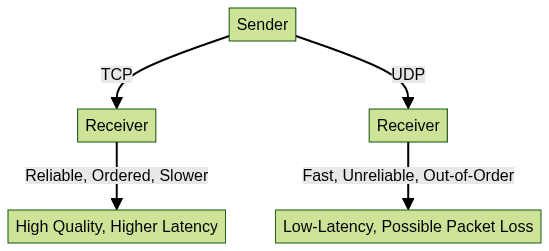Streaming Protocols Comparison: Choosing the Best for Your Needs
Introduction to Streaming Protocols Comparison
In 2025, the landscape of video and
live streaming
continues to evolve at a rapid pace. At the heart of this evolution are streaming protocols—sets of rules that dictate how audio and video data is transmitted over networks. The right streaming protocol is crucial for delivering seamless, high-quality experiences to users across devices. Whether you’re building a live broadcasting platform, a video-on-demand service, or integrating real-time communication in your app, understanding the strengths and weaknesses of each protocol is essential. This streaming protocols comparison will explore popular protocols, including RTMP, HLS, WebRTC, SRT, MPEG-DASH, and more. We’ll cover their use cases, technical characteristics, security, and how to choose the best streaming protocol for your application in 2025.Understanding the Basics: What Are Streaming Protocols?
Streaming protocols are standardized methods for transmitting multimedia data (audio, video, metadata) from one point to another over IP networks. Unlike codecs, which are responsible for compressing and decompressing audio or video streams, and container formats, which bundle different types of media together, streaming protocols manage the transportation and delivery of data packets. In the streaming workflow, once audio and video are encoded and packaged into containers, streaming protocols carry the resulting data to viewers’ devices. Choosing the right protocol impacts latency, scalability, security, and interoperability, making streaming protocols comparison a key step in architecting any video delivery solution. For developers building cross-platform video apps, understanding options like
webrtc android
andflutter webrtc
is increasingly important.TCP vs UDP: Foundation of Streaming Protocols
Transmission Control Protocol (TCP) and User Datagram Protocol (UDP) are the underlying transport protocols for most streaming protocols. TCP emphasizes reliability, ensuring packet order and retransmission of lost data, which is ideal for VOD but can introduce latency. UDP, on the other hand, is connectionless and prioritizes speed by sending packets without waiting for acknowledgments, making it suitable for low-latency
live streaming
. The choice of TCP vs UDP in your streaming protocols comparison directly affects performance and reliability.
Popular Streaming Protocols Overview
In this streaming protocols comparison, we’ll evaluate the following popular protocols:
- RTMP (Real-Time Messaging Protocol)
- HLS (HTTP Live Streaming)
- WebRTC (Web Real-Time Communication)
- SRT (Secure Reliable Transport)
- MPEG-DASH (Dynamic Adaptive Streaming over HTTP)
- RTSP (Real-Time Streaming Protocol)
- CMAF (Common Media Application Format)
- RIST (Reliable Internet Stream Transport)
- FTL (Faster Than Light)
When building interactive video experiences, many developers leverage a
Video Calling API
to simplify integration of real-time streaming protocols like WebRTC.In-Depth Streaming Protocols Comparison
RTMP (Real-Time Messaging Protocol)
RTMP, initially developed by Macromedia (now Adobe), was the de facto standard for ingesting live video to platforms like YouTube and Twitch. Operating over TCP, RTMP enables real-time transmission with relatively low latency. Its simplicity and wide encoder support made it popular for live streaming, but browser support has declined due to Flash deprecation. RTMP is still widely used for first-mile ingest.
Pros: Simple setup, low ingest latency, broad encoder support.
Cons: Lacks native end-user device support, no built-in encryption, outdated for direct playback.
HLS (HTTP Live Streaming)
HLS, developed by Apple, is the most widely used protocol for video delivery in 2025. It segments video into small HTTP-based files, enabling adaptive bitrate streaming for smooth playback across varying network conditions. HLS is supported natively on iOS, macOS, Android, smart TVs, and browsers. However, segment-based delivery introduces higher latency (typically 6-30 seconds), though recent Low-Latency HLS (LL-HLS) extensions have improved this.
For mobile developers, integrating HLS with
webrtc android
orflutter webrtc
can help deliver seamless live video experiences across platforms.Pros: Universal device support, adaptive bitrate, scalable via standard HTTP/CDN.
Cons: Higher latency, especially for live streaming, compared to real-time protocols.
WebRTC (Web Real-Time Communication)
WebRTC is designed for ultra-low latency and real-time interactions, such as video conferencing and live auctions. It operates peer-to-peer, supports NAT traversal, and provides built-in encryption for secure media transport. WebRTC is natively supported in all major browsers, making it ideal for web-based real-time apps. However, large-scale broadcasting requires SFUs (Selective Forwarding Units) or MCUs (Multipoint Control Units).
If you're developing for mobile,
webrtc android
andflutter webrtc
are essential resources for implementing real-time communication. Additionally, using a robustVideo Calling API
can further streamline the integration of WebRTC into your applications.Pros: Sub-second latency, browser-native, secure by default.
Cons: Scalability can be complex, higher infrastructure overhead for large audiences.
SRT (Secure Reliable Transport)
SRT is an open-source, UDP-based protocol optimized for reliable, low-latency transport over unpredictable networks. It features packet loss recovery, encryption, and firewall traversal, making it popular for remote contribution and cloud ingest in professional workflows. SRT is codec-agnostic and widely adopted by broadcasters.
Pros: Low latency, resilient to network issues, secure, open-source.
Cons: Not natively supported on consumer devices for playback, needs conversion to HLS/DASH for end-user delivery.
MPEG-DASH (Dynamic Adaptive Streaming over HTTP)
MPEG-DASH is an open standard for adaptive streaming, similar to HLS but codec-agnostic and widely supported on modern browsers, smart TVs, and set-top boxes. It operates over HTTP, enabling CDN scalability and adaptive bitrate streaming. DASH supports DRM integration and is often used for large-scale VOD and live OTT services.
For applications requiring real-time features, combining MPEG-DASH with a
Video Calling API
can bridge the gap between adaptive streaming and interactive communication.Pros: Standards-based, adaptive, supports multiple codecs, DRM-ready.
Cons: Not natively supported on iOS browsers, higher latency compared to real-time protocols.
RTSP (Real-Time Streaming Protocol)
RTSP is a pull-based protocol often used with IP cameras and surveillance systems. It controls streaming sessions and works with RTP for media delivery. RTSP offers low latency but lacks widespread browser support and requires dedicated players or conversion.
Pros: Low latency, ideal for surveillance and security.
Cons: Limited device/browser support, legacy technology for consumer streaming.
CMAF (Common Media Application Format)
CMAF standardizes media chunks for both HLS and DASH, enabling low-latency streaming and reduced storage/transcoding costs. By using a common format, CMAF simplifies workflow and improves compatibility across devices and protocols.
Pros: Reduces latency, improves workflow interoperability.
Cons: Still requires HLS/DASH for delivery, limited device support without fallback.
RIST (Reliable Internet Stream Transport)
RIST is designed for professional broadcast contribution, offering reliable, low-latency delivery over unmanaged networks. It’s open, interoperable, and ideal for remote production and broadcast workflows.
Pros: High reliability, open standard, professional-grade.
Cons: Niche use case, not for end-user device playback.
FTL (Faster Than Light)
FTL, developed by Mixer, is engineered for ultra-low latency live streaming, supporting real-time interaction between streamers and viewers. FTL achieves sub-second latency but is less widely supported outside specific platforms.
Pros: Ultra-low latency, ideal for real-time engagement.
Cons: Limited ecosystem, proprietary origins.
Comparison Table: Streaming Protocol Features
Below is a Markdown code snippet for a streaming protocols comparison table:
1| Protocol | Latency | Device Support | Security | Adaptive Streaming | Typical Use Cases |
2|------------|--------------|-------------------------|------------------|--------------------|-------------------------------------|
3| RTMP | Low | Encoders, Servers | Optional | No | Ingest, live streaming |
4| HLS | Medium-High | Universal (browser, TV) | AES-128, DRM | Yes | VOD, live OTT, large audiences |
5| WebRTC | Ultra-low | Browsers, Mobile | DTLS/SRTP | No | Real-time, video chat, auctions |
6| SRT | Low | Professional gear | AES-128/256 | No | Remote ingest, contribution |
7| MPEG-DASH | Medium-High | Browser, TV, Android | DRM | Yes | VOD, live OTT, cross-platform |
8| RTSP | Low | IP cameras, VLC | Basic | No | Surveillance, monitoring |
9| CMAF | Low-Med | Modern browsers, TV | DRM | Yes | Low-latency OTT, unified workflow |
10| RIST | Low | Broadcast equipment | AES-128/256 | No | Professional contribution |
11| FTL | Ultra-low | Mixer platform | TLS | No | Real-time, audience interaction |
12Protocol Selection: Choosing the Best Streaming Protocol for Your Use Case
Selecting the best streaming protocol depends on application requirements. Consider latency (real-time vs. VOD), scalability (audience size), device compatibility, security, and workflow complexity. For example, HLS or MPEG-DASH is ideal for large-scale VOD and live streaming, while WebRTC suits interactive real-time applications. SRT or RIST excel in professional broadcast contribution.
For developers seeking to enable cross-platform video chat, leveraging a
Video Calling API
can help abstract the complexity of protocol selection and integration.
Security Considerations in Streaming Protocols
Security is critical in any streaming protocols comparison. Modern protocols offer encryption (TLS, SRTP, AES), DRM integration for content protection, and secure transport features. WebRTC, SRT, and RIST provide built-in security, while HLS and DASH depend on DRM and HTTPS. Always ensure your protocol and workflow comply with privacy and copyright regulations.
Future Trends and Innovations in Streaming Protocols
The future of streaming protocols in 2025 is focused on reducing latency, supporting AI-driven adaptive streaming, and enabling hybrid workflows that combine the strengths of multiple protocols. Protocol consolidation—standardizing on formats like CMAF—improves interoperability, while edge computing and 5G drive innovation in real-time streaming.
Conclusion: Finding the Best Fit
There is no one-size-fits-all streaming protocol. Use this streaming protocols comparison to evaluate your needs and select the protocol that best aligns with your application’s requirements in 2025.
Want to level-up your learning? Subscribe now
Subscribe to our newsletter for more tech based insights
FAQ